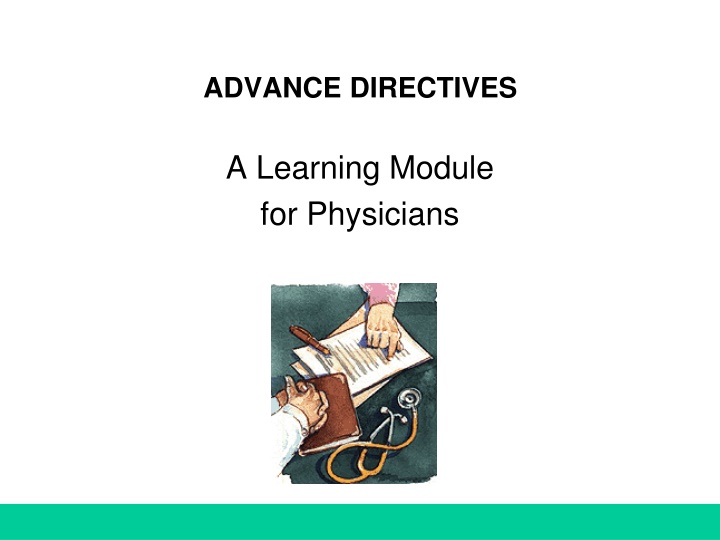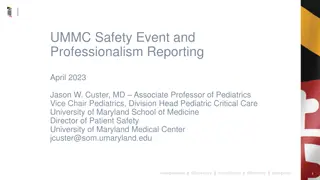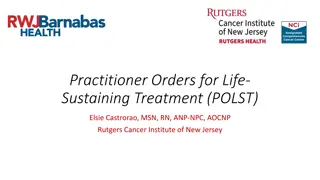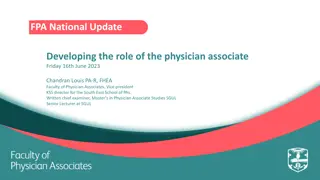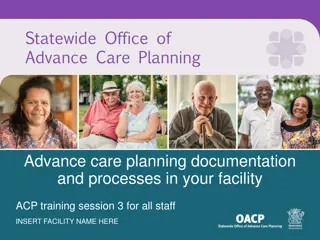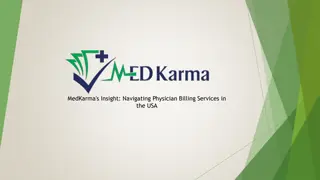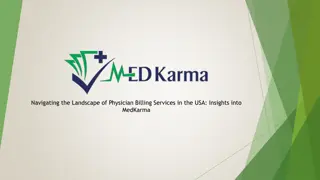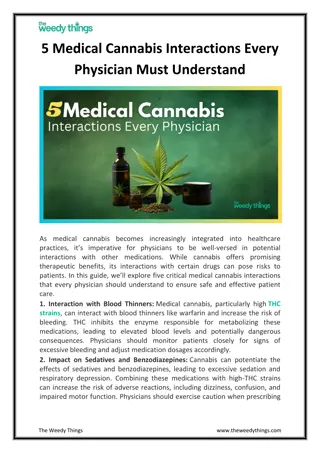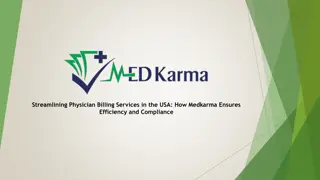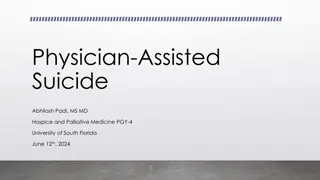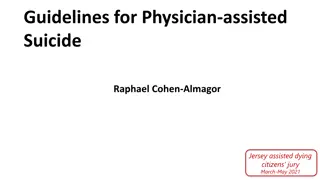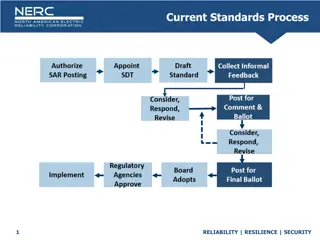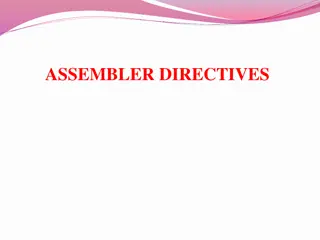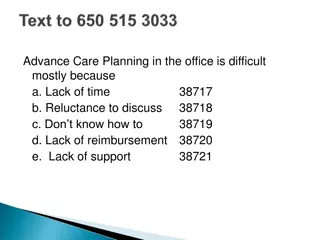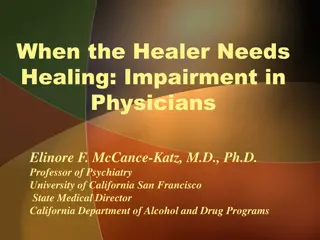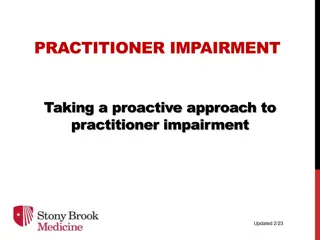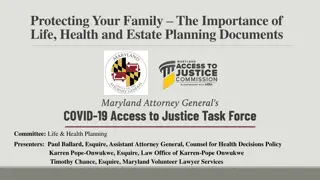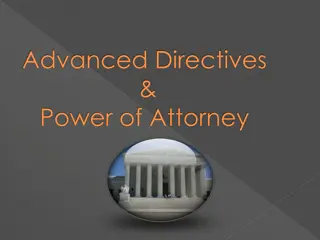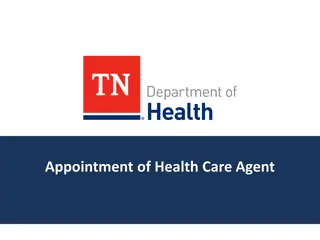Physician's Learning Module for Advance Directives
This module equips physicians with factual information on advance directives to enhance patient and family education. Covering a brief history of advance directives, types used in New York State, and distinctions between MOLST and Non-Hospital DNR forms. Learn how advance directives help convey patients' wishes and ensure they are respected even in inability to communicate.
Download Presentation

Please find below an Image/Link to download the presentation.
The content on the website is provided AS IS for your information and personal use only. It may not be sold, licensed, or shared on other websites without obtaining consent from the author.If you encounter any issues during the download, it is possible that the publisher has removed the file from their server.
You are allowed to download the files provided on this website for personal or commercial use, subject to the condition that they are used lawfully. All files are the property of their respective owners.
The content on the website is provided AS IS for your information and personal use only. It may not be sold, licensed, or shared on other websites without obtaining consent from the author.
E N D
Presentation Transcript
ADVANCE DIRECTIVES A Learning Module for Physicians
Purpose This program is intended to help physicians obtain factual information regarding advance directives to enhance patient and family education. Objectives 1. Review a brief history of advance directives 2. Discuss the types of advance directives used in New York State 3. Learn the difference between a MOLST and a Non-Hospital DNR form
Brief History of Advance Directives Karen Quinlan, 1970s Important person in the history of the right to die (right to refuse extraordinary measures) controversy in the United States Set precedent for withdrawal of life support Led to development of formal Ethics Committees in institutions Nancy Cruzan v. US Supreme Court, 1989-1990 Supreme Court ruled it was acceptable to require "clear and convincing evidence" of a patient's wishes for removal of life support. A significant outcome of the case was the creation of advance health directives Patient Self Determination Act, Effective December 1991 Requires health care providers (hospitals, nursing homes, HMOs, etc) to provide information about advance directives to patients upon admission Family Health Care Decisions Act (FHCDA), Effective June 1, 2010 Helps identify a decision maker when the patient lacks capacity and did not leave prior instructions or appoint a health care agent The decision maker identified using the FHCDA is known as a Public Health Law (PHL) surrogate
Advance Directives Advance directives are written instructions for health care, that indicate a person s wishes and/or designate a trusted person in the event that they become unable to make decisions for themselves. They are ideally prepared in advance of a health care crisis when the patient is of sound mind and is able to communicate their wishes.
Advance Directives cont. Advance directives attempt to determine what medical treatment the person would choose, given the opportunity, based on diagnosis and prognosis. They also provide an opportunity to candidly discuss the patient s wishes with family and friends and to initiate serious discussions with their physician.
Advance Directives cont. Advance directives ensure that a patient s wishes are known regarding their own health and that they will be followed and respected even when they can no longer communicate. Although most people equate the need for advance directives with age, it is strongly recommended that all able adults over the age of 18 discuss their wishes with their family and friends, and fill out a health care proxy accordingly.
Advance Directives cont. At Crouse Hospital, if a patient has an advance directive, but does not have a copy with them on admission, the intent of the advance directive is recorded in the patient s own words on admission. The doctor should be notified ASAP to initiate a conversation with the patient. If the patient does have prior advance directives in their medical record history, the patient needs to be asked if they want them continued or if they want to make a change.
Types of Advance Directives Advance directives differ by state Examples of New York State advance directives are: Living Will: written document demonstrating clear and convincing evidence of a person s wishes Health Care Proxy: gives a person authority to make medical decisions for an individual, it becomes active only when the individual loses capacity to make their own decisions MOLST: medical order form that details the patient s wishes for life-sustaining treatments *Durable Power of Attorney*: relates to financial and estate planning, not used in health care decision making in NYS; other states differ Surrogate Family Health Care Decisions Act Relates to incapacitated adult patient The law only applies to patients in hospitals and nursing homes who have lost the capacity to make medical treatment decisions and who have not appointed an agent under a health care proxy.
Living Will The living will gives specific instructions and expresses the patient s wishes and beliefs as to the withholding or withdrawal of life-sustaining treatment (LST). A living will does not appoint a person to make decisions in place of the incapacitated patient as with a proxy directive, but sometimes the living will and health care proxy forms are combined into one document.
Living Will cont. The maker of a living will attempts to predict the health care issues that may arise in the future, and states in writing choices regarding care that should or should not be administered. It is meant to guide decision makers. It usually addresses Life-Sustaining Treatments for patients who are: Terminal Permanently unconscious Not likely to regain the ability to make decisions In New York State, a living will is clear and convincing evidence of a patient s wishes, however it is not an actionable order, you still need a decision maker (HCP or PHL surrogate) to execute the order
Health Care Proxy The Health Care Proxy Law allows a person to name an individual to act on the person s behalf to make health care decisions if the person becomes unable to make decisions for themselves The person chosen as health care agent should be someone trusted to follow the patient s wishes and any cultural or religious philosophies.
Health Care Proxy cont. The health care agent will serve as an advocate for the patient, even if they themselves would make different decisions in a similar situation. If a patient has multiple Health Care Proxy documents, the one with the most current date should be followed. Only a patient can appoint and void their Health Care Proxy.
Medical Orders for Life-Sustaining Treatment (MOLST) The MOLST is a physician order form used statewide that provides specific medical orders. It is intended for patients with serious health conditions who: Want to avoid or receive any or all life-sustaining treatment Reside in a long-term care facility or require long-term care Might die within the next year Page 1 lists the options for DNR or CPR in the event of actual cardiac &/or respiratory arrest Page 2 lists the other orders for life-sustaining treatment (intubation, feeding tube placement, antibiotics, etc) MOLST is the only form authorized in NYS for documenting both DNR and DNI orders
MOLST vs. Nonhospital DNR MOLST Only actionable DNI order in NYS Lists both DNR and DNI orders Nonhospital DNR Does not indicate DNI as an option Patients may get intubated by Emergency Services personnel if NOT yet in cardiac/respiratory arrest
Nonhospital Order Not to Resuscitate (DNR Order) Do not resuscitate (DNR) means, for a patient in cardiac and/or respiratory arrest, NO chest compressions, ventilation, defibrillation, endotracheal intubation, or ACLS medications. If the patient is NOT in cardiac and/or respiratory arrest, full treatment for all injuries, pain, difficult or insufficient breathing, hemorrhage and/or other medical conditions must be provided.
DNR Orders DNR orders can be initiated by the patient or, if the patient is unable to take part in healthcare decisions, DNR orders can be initiated by an HCP or PHL surrogate. If the patient has no Health Care Proxy, no Public Health Law surrogate, and no family or friends that are able or willing to make decisions for the patient, 2 physicians can initiate a DNR order for the patient, only if they feel death is imminent and the patient will die with or without life-sustaining treatment.
DNR Orders cont. DNR orders can be obtained as verbal consent in person or over the phone, as long as there are 2 witnesses. One of the witnesses can be the physician signing the order. The DNR order needs to be signed by the physician within 24 hours of completion. In the hospital, a DNR order should be reviewed every 7 days by the physician and each review should be signed and dated. However, even if the order is not signed, the most important thing is to honor the patient s wishes.
Conclusion Health care workers must be encouraged to discuss questions and concerns regarding advance directives with their patients, who rely on them for accurate information.
